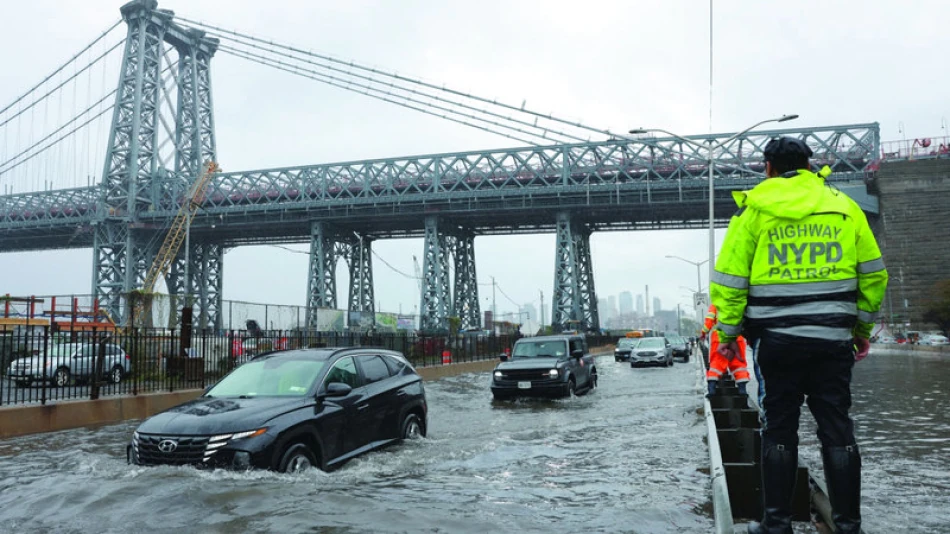
Torrential Storms Intensify in New York Amid Escalating Climate Crisis
New York's $46 Billion Climate Reality Check: When 150-Year-Old Infrastructure Meets Modern Storms
Monday night's torrential downpour in New York City delivered a stark reminder that America's largest metropolis is fighting climate change with Victorian-era infrastructure. The storm, which dumped over 5 centimeters of rain in Central Park within a single hour, represents more than just extreme weather—it's a preview of the financial and engineering challenges facing coastal megacities worldwide as climate patterns fundamentally shift.
When Weather Records Become Routine
The Monday deluge shattered precipitation records dating back to 1869, when New York first began systematic weather tracking. What makes this particularly alarming isn't just the intensity, but the frequency. The city's subway system, engineered to handle up to 4.5 centimeters of rainfall per hour, was overwhelmed by 5.25 centimeters—the highest hourly rainfall ever recorded in the city's history.
The human cost was immediate and tragic. In neighboring New Jersey, where over 15 centimeters fell in just over an hour, at least two people died when their vehicle was swept off the road. Governor Phil Murphy declared a state of emergency, while viral videos showed flood waters erupting like geysers from subway grates in Manhattan's 28th Street station.
The New Math of Extreme Weather
The statistics paint a troubling picture of accelerating change. Before 1991, no storm had ever exceeded the subway system's design capacity. Since then, it has happened six times, including Monday's event. New York now experiences an additional day of heavy rainfall annually compared to the late 19th century—a seemingly small shift with massive infrastructure implications.
Recent research indicates that storms like Hurricane Ida, which killed 14 people in the Northeast in September 2021, are now 4 to 52 times more likely due to climate change. A separate 2021 study found that rainfall storms in the Northeast are intensifying faster than anywhere else in the country.
The Billion-Dollar Band-Aid Problem
Mayor Eric Adams has allocated over $1 billion for stormwater drainage improvements over the past three years—a substantial investment that experts say barely scratches the surface of what's needed. The city's own flood protection plan estimates requiring $46 billion to defend against a once-in-a-century storm, highlighting the massive gap between current spending and actual needs.
"We have infrastructure designed for an environment we no longer live in," said Rohit Aggarwala, New York City's chief climate officer. This sentiment echoes across coastal cities globally, from Miami to Mumbai, where aging infrastructure confronts increasingly volatile weather patterns.
The Atlantic Ocean's Growing Threat
Beyond inland flooding, New York faces a dual challenge from the Atlantic Ocean. Rising sea levels, combined with retreating Arctic sea ice that's altering weather patterns, are creating more extreme and powerful storms. Hurricane Sandy in 2012 provided a devastating preview, flooding the subway system with saltwater and causing $19 billion in city damages alone.
This month's research shows that winter storms in the Northeast are becoming more destructive as these oceanic and atmospheric changes accelerate. The combination of sea-level rise and changing storm patterns creates a compound threat that traditional infrastructure simply wasn't designed to handle.
Global Implications for Urban Planning
New York's predicament reflects a broader challenge facing coastal megacities worldwide. Singapore has invested heavily in flood management systems, while the Netherlands continues expanding its sophisticated sea barrier networks. The UAE has begun integrating climate resilience into its urban planning from the ground up.
The key difference lies in timing and scale. Cities building new infrastructure can incorporate climate projections from the start, while established metropolises like New York must retrofit century-old systems at exponentially higher costs.
Investment and Insurance Implications
For investors and insurers, Monday's storm reinforces the growing financial risks of climate change in urban areas. Infrastructure bonds, real estate investments, and insurance premiums in coastal cities will likely reflect these escalating risks. The $46 billion price tag for adequate flood protection represents just one city's needs—multiplied across dozens of vulnerable coastal areas globally, the investment requirements become staggering.
The recurring nature of these events also signals a shift from viewing extreme weather as occasional disasters to recognizing them as regular operational challenges requiring permanent solutions. This fundamental change in perspective will likely drive new approaches to urban planning, infrastructure investment, and climate adaptation strategies in the coming decades.
Most Viewed News

 Sara Khaled
Sara Khaled






